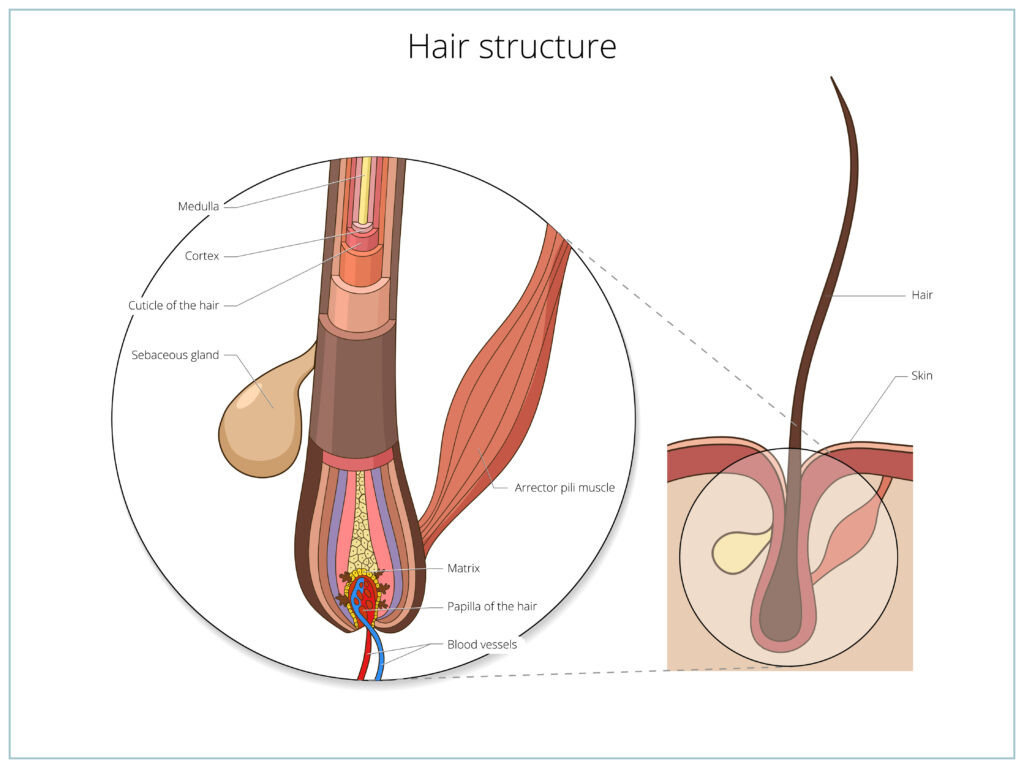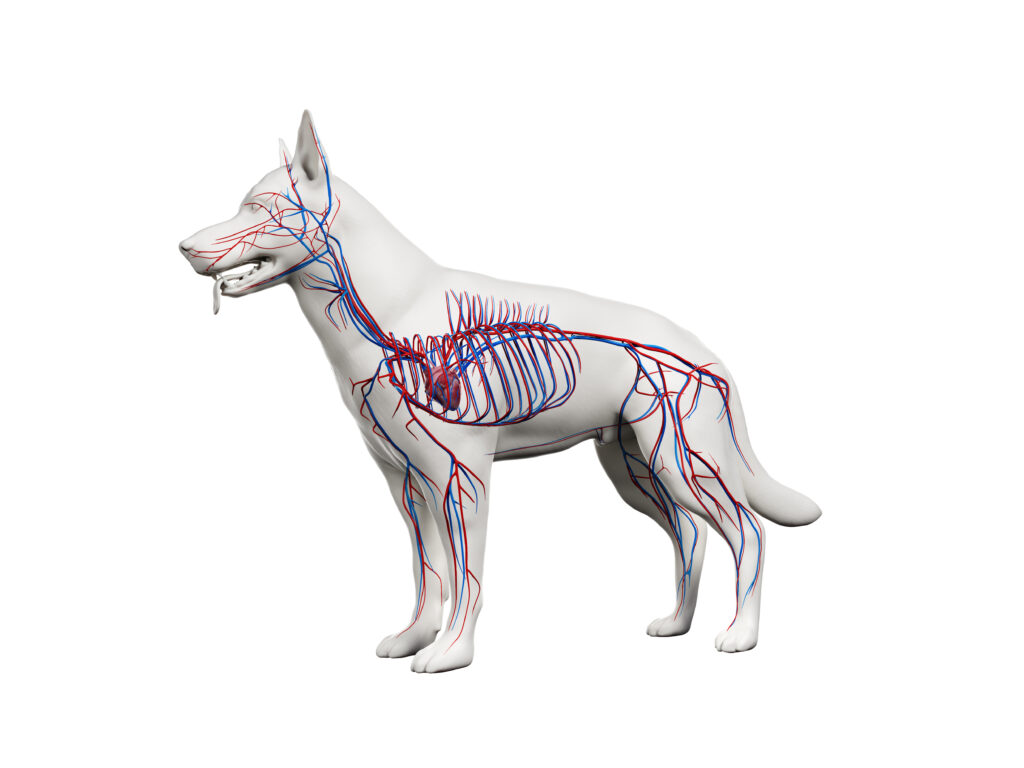
Fur mineral analysis can provide a lot of information about long-term exposure to environments and to the impact a diet is having on the nutritional status of the dog or cat. For many, fur analysis may be unfamiliar so here is a basic overview of some important information on fur.
In this article:
- How “stuff” gets incorporated into fur
- How fast does fur grow?
- Fur & the endocrine system
- Blood: just the “1 percenter”
How “stuff” gets incorporated into fur
The incorporation of minerals, environmental elements, and toxins into fur happens primarily through the bloodstream via the follicle. Here’s a step-by-step look at the process:
- Absorption: Minerals, environmental elements, and toxins first enter the body through various routes. For example, minerals are primarily absorbed from the food pets eat. Toxins and environmental elements can be ingested, inhaled, or absorbed through the skin.
- Distribution: Once these substances are absorbed, they enter the bloodstream. The blood then transports these substances throughout the body.
- Incorporation into Hair: The hair follicle, which is the organ that produces hair, has a rich blood supply. As hair grows, it is exposed to the internal metabolic environment, including the blood. Thus, the substances carried by the blood, including minerals, environmental elements, and toxins, get incorporated into the growing hair.
- Growth and Hardening of Hair: As the hair continues to grow and reaches the surface of the skin, it hardens, and the substances incorporated into the hair become trapped, providing a record of exposure over time.

Besides the bloodstream, sweat and sebum (the skin’s natural oils) can also deposit substances onto the hair shaft.
It’s also worth noting that the levels of substances in hair may not always reflect levels in other parts of the body or indicate a specific health condition. Hair analysis should be used as a part of a comprehensive health assessment and not as a standalone diagnostic tool. Both blood and hair mineral analysis is important for evaluating the patient’s diet and overall health. Both can be used to monitor a change in diet, effect of medication, or health status.
How fast does fur grow?
Hair growth in animals varies widely based on the species, breed, age, health, and even the specific region of the body. Since hair growth can vary significantly based upon species, breed, and age, the timeframe hair analysis represents can vary from 1 to 3 months. Here are some general estimates for a few common companion animals:

Dogs:
Hair growth rates in dogs can vary significantly depending on the breed and type of coat. Breeds with continuously growing hair, like Poodles or Shih Tzus, can see hair growth rates of up to 1 cm per month. Pomeranians, who have a long hair growth cycle, have an average hair growth rate of about 1.4 cm per month. On the other hand, breeds with double coats that shed seasonally, such as Siberian Huskies or Golden Retrievers, may have slower growth rates and periods of more rapid shedding.
Cats:
Cats generally have a hair growth rate of about 0.5 cm per month with DSH at 0.81 cm per month, but this can also vary depending on factors such as breed, age, and health.
Horses:
Horse hair, specifically mane and tail hair, can grow at a rate of approximately 0.5 to 1.25 cm per month. Again, this can vary with factors like breed, age, and overall health.
Fur Mineral Analysis is Less Affected by Endocrine Control
The endocrine system plays a crucial role in maintaining homeostasis in the body, including the balance of minerals. Here are some ways the endocrine system helps regulate key minerals:
- Calcium and Phosphorus: The parathyroid glands produce parathyroid hormone, which acts on the bones, kidneys, and intestines to increase blood calcium levels. The thyroid gland produces calcitonin, which has the opposite effect. Phosphorus levels are regulated inversely to calcium.
- Sodium, Potassium, and Chloride: The adrenal glands produce a hormone called aldosterone, which regulates these electrolytes.
- Magnesium: Magnesium is primarily regulated by the kidneys, under the influence of both PTH and calcitonin.
- Iron: While not directly regulated by a specific hormone, iron levels are influenced by hepcidin, a hormone-like substance produced by the liver.
Since fur mineral analysis is a reflection over time of the body’s cellular stores, it is less affected by endocrine’s demands to maintain normal physiological functions.
Blood: just the “1 Percenter”
Minerals play a vital role in maintaining overall health and are stored in various parts of the body. Here are the primary storage sites for several essential minerals:
- Calcium and Phosphorus: Over 99% of the body’s calcium and about 85% of phosphorus reside in the skeletal system. Blood is less than 1%.
- Magnesium: About 50-60% of magnesium is stored in the bones, 38-40% in cells, and 1-2% in blood.
- Potassium: 98% within body cells. Only about 2% of the body’s potassium is found in the blood.
- Sodium and Chloride: These electrolytes are primarily found in body fluids, including blood and extracellular fluid.
- Iron: The largest amounts of iron are found in hemoglobin in red blood cells. Excess iron is stored in the liver, spleen, and bone marrow as ferritin and hemosiderin.
- Zinc: This mineral is found throughout the body but is most concentrated in the cells and bones.
- Copper: The liver is the primary storage site for copper.
- Iodine: This mineral is stored in the thyroid gland, where it is used to make thyroid hormones.
- Selenium: This mineral is widely distributed throughout the body, with the highest amounts found in the liver, kidneys, and pancreas.
- Manganese: This trace mineral is predominantly stored in the bones, with the rest distributed throughout the body in tissues like the liver, pancreas, and kidneys.
These minerals can be mobilized from their storage sites when needed to maintain normal physiological functions, however minerals are not extracted from fur – once captured they remain.
The 1 Percenter is Blood: Except for electrolytes, blood accounts for a small fraction of the body’s mineral stores.

Testing Fur with VDI Laboratory
VDI offers a mineral and toxic metal fur analysis for cats and dogs. Visit a link below to learn more or to get started.
